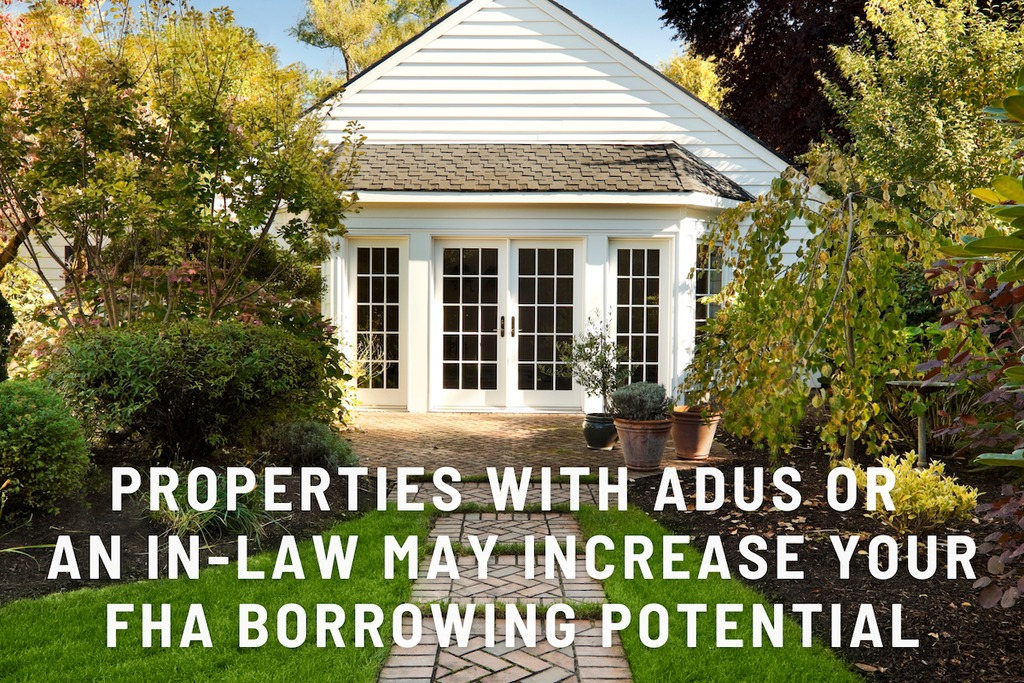Qualifying for an FHA loan just became easier for buyers of properties with ADUs and other rental spaces.
Mortgage lenders can now count income from small units of housing — known as Accessory Dwelling Units (ADUs) — built inside, attached to, or on the same property as a primary residence when underwriting a mortgage.*
This exciting new change in FHA lending rules happened in November 2023.
According to HUD, this change allows for the inclusion of rental income from the ADU in the borrower’s qualifying income and would allow more borrowers to qualify for FHA financing for properties with ADUs, including 203(k) Rehabilitation mortgages. The CalHFA guidelines website has already added “Guest houses, granny units and in-law quarters may be eligible” to its guidelines for eligible properties.
*(The U.S. Department of Housing and Urban Development, through the Federal Housing Administration (FHA) made this policy effective November 18, 2023 as part of a Biden- Harris Administration initiative to increase the housing supply. Read all the details from FHA.)
What is an Accessory Dwelling Unit (ADU)?
FHA defines an ADU as:
- a single habitable living unit
- with a means of separate ingress and egress
- that meets the minimum requirements for a living unit.
When looking for property online, look for phrases such as “guest house” “cottage” and “in-law” in addition to “ADU.”
An ADU is a private space that is subordinate in size and can be added to, created within, or detached from a primary one-unit single-family dwelling.
In California and other state there are “minesterial” rules governed by the state that every local town or city must allow without question. Each city or county can further specify rules for their area.
To find out more, contact your local city or county where you are thinking of purchasing a property that has an ADU or where you are thinking of adding an ADU to ask them about the local rules and ordinances.
Why is HUD allowing ADU rental income to count toward mortgage qualification?
According to the HUD press release, the new policies has several key goals:
- enable more homeowners with limited incomes to build ADUs, helping them sustain homeownership and expanding the production of ADUs as rental housing.
- enable more first-time homebuyers, seniors, and inter-generational families to leverage the power of ADUs to enhance the generational wealth building potential of homeownership.
- ADUs can be rented out to tenants, thereby adding to the supply of housing in a community.
Ways the new FHA policy counting ADU rental income helps home buyers
- Allows 75% of the estimated ADU rental income for some borrowers to qualify for an FHA-insured mortgage on a property with an existing ADU.
- Uses 50% of the estimated rental income, for some borrowers, from a new ADU the borrower plans to attach to an existing structure [usually known as a JADU, or Junior ADU], such as in a garage or basement conversion, to qualify for a mortgage under FHA’s Standard 203(k) Rehabilitation Mortgage Insurance Program.
- Includes ADU-specific appraisal requirements for appraisers to clearly identify, analyze, and report on ADU characteristics and the estimated rent the ADU can be expected to generate. The guidance provided in the Mortgagee Letter will assist appraisers to more accurately determine the market value of a property with an ADU and also will help advance the maturation of ADU valuation, thereby increasing access to ADU financing as more cities and states remove zoning barriers.
- Add ADUs to the types of improvements that can be financed under FHA’s mortgages for new construction. [This is huge!] This policy allows new homes to be built with ADUs from the ground up, an important source of ADU production in addition to rehabilitating existing structures.
Get in touch to connect with an FHA lender and to chat about maximizing your home investment. There’s been no better time to find a perfect multi-generation property, age in place, and build multi-generation wealth thanks to this new FHA rule.




